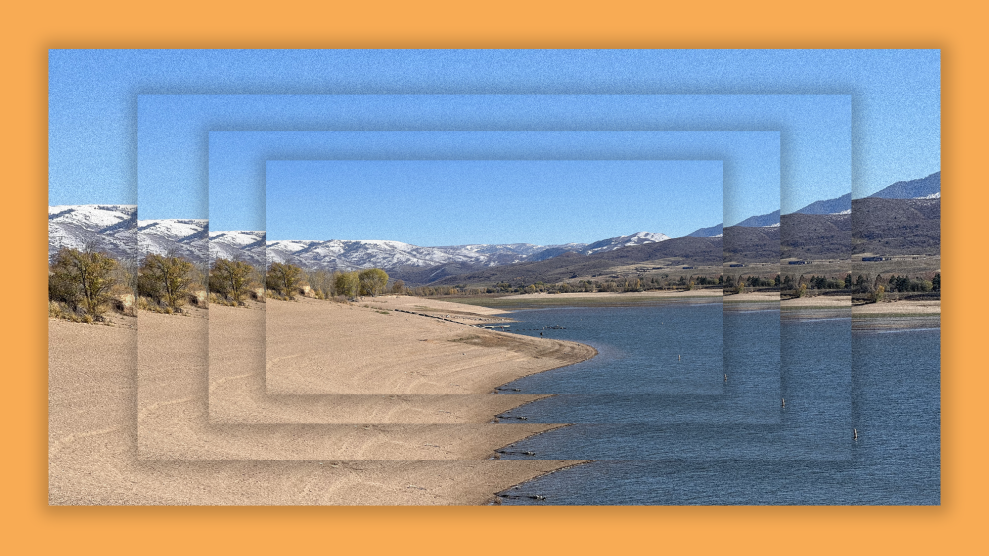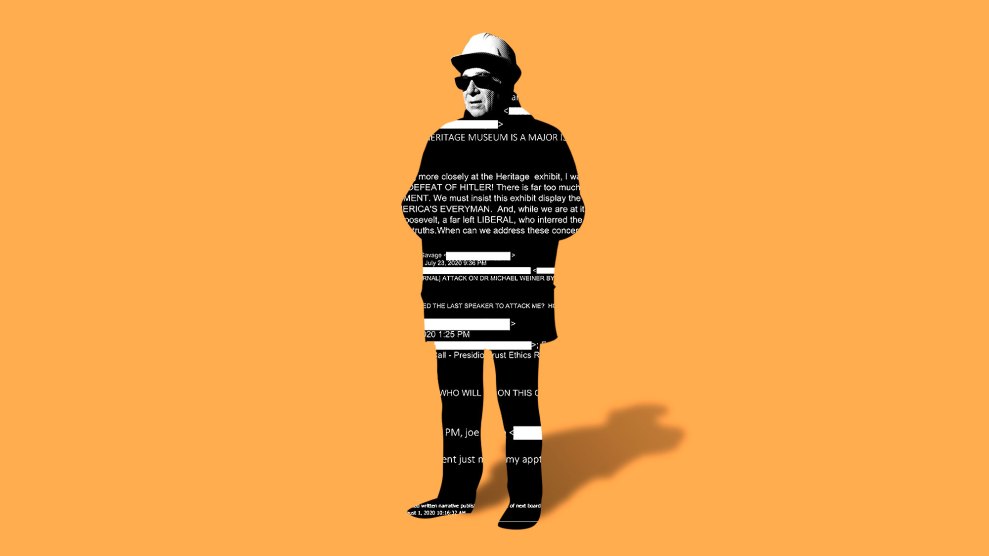
Mother Jones illustration; Westwind Air Service/Unsplash
As usual, the staff of Mother Jones is rounding up the heroes and monsters of the past year. Find all of 2021’s heroes and monsters here.
The Narrows is one of the most popular areas in Utah’s Zion National Park. Its 1,000-foot walls soar above a thin flow of the Virgin River that serves as the only trail through that part of the canyon. On December 29 last year, officials posted on Facebook that a park ranger patrolling the Narrows had collected 14 pounds of trash, including nine pounds of human waste, in less than a mile. “The graffiti was the worst I’ve ever seen,” Ranger John reported. “It seemed like the entire stretch I walked had something left on the rock: a handprint, a name, and I won’t go into detail about the poop.”
During the pandemic, millions of Americans decided to get out and experience the great outdoors for the first time. It might be time for them to go back inside. These newby outdoor wreckreationalists have become a blight on the nation’s public lands, heading out into the wild where they’re shocked to discover there are no bathrooms. They’re leaving behind a trail of epic destruction—forest fires, graffiti, trash, human waste—and otherwise treating our greatest natural treasures like Disney theme parks. Then again, most Disney visitors probably wouldn’t dream of taking a dump on Mickey’s sidewalk or setting fire to Space Mountain.
The crotchety environmental writer Edward Abbey called Arches National Park the “most beautiful place on earth.” In the 1950s, he worked there as a seasonal park ranger, gathering string for his book Desert Solitaire and trying to sabotage the paving of a road that today sees massive traffic backups into the park. Back then, Arches saw 3,000 annual visitors. Just in the month of April this year, 200,000 visitors fought their way into the park, a 15 percent increase over the already high numbers of 2019.
Arches and nearby Canyonlands National Park have fewer than 100 legal camping spaces between them, a fact that did not deter people this summer from trying to pitch tents there or on nearby federal land that isn’t equipped for campers. “People could be parked right next to a sign that says, ‘closed to camping’ and they’re just like, ‘But the app said it was open,’” Nicollee Gaddis-Wyatt, a BLM field manager in Moab told the Wall Street Journal earlier this year. Some of those campers left a fire unattended this spring, igniting a blaze that burned more than 5,000 acres 20 miles south of Moab. In November, park rangers hauled 150 pounds of trash out of an illegal backcountry camp in the famous park.
The stupidity is well traveled. The Appalachian Trail has also been overrun in the past two years, with a Washington Post reporter observing in August that the pandemic “has transformed the world’s longest hiking-only footpath from a bucolic refuge to a linear version of Costco on a Saturday.” While reporting on a stretch of the trail in Virginia known as “the roller coaster,” she observed a hiker scoop a pile of dog crap into a bag and then toss the bag on the side of the trail. She found a bag of feces tied to a tree. Hikers were blasting music from a stereo.
Overuse of public lands didn’t start with the pandemic, but it sure feels that way. The hey-let’s-try-hiking crowd is not only ruining public lands, they’re overwhelming local search and rescue teams that are having to haul them off the mountains after they do something stupid.
Rather than enjoying a leisurely Thanksgiving this year, forest rangers in the Adirondack Park were dispatched to Mount Marcy, the highest peak in New York State, whose elevation tops 5,300 feet above sea level. The temperature at the summit can be 20 degrees lower than at the base, and the trail can be slick when it’s wet; experienced hikers only assault Mt. Marcy in the winter equipped with snowshoes and crampons. But on Thanksgiving, three sneaker-shod hikers called the emergency dispatch asking for a ride off the mountain because there were eight inches of snow on the summit and their feet were frozen.
There is no road down Mount Marcy. The roundtrip hike to the top is 15 miles with a 3,000-foot elevation change, a challenge to complete in one day when the sun sets at 4:21 p.m., as it did on Thanksgiving. The hikers made their distress call at 4:50. The Department of Environmental Conservation reported that the rescue was delayed because the hikers couldn’t read a map properly and thus couldn’t tell the rangers where, exactly, they were stuck. Rescuers didn’t get them off the mountain until 10:30 that night.
Adirondack search and rescues have been at a record high for two years running now, and the DEC rescue reports are a catalogue of people who seem to be fleeing COVID by rushing headlong off a cliff. Rangers describe the unprepared hikers who hit the trail without food and water and then got lost or dehydrated; the 74-year-old New Jersey man who thought he was hiking Wright Peak but was actually on Algonquin; people rescued after attempting a high peaks ascent in flip flops; lost tourists who set off into the wilderness without maps, headlamps, or warm clothes. And so many others who think the AllTrails app will save them, at least until it drains their phone battery an hour up the trail. The phenomenon is happening all over the country, as the uninitiated are lured to iconic wilderness landscapes by Instagram and Snapchat images, which don’t reflect the work it takes, or the risks involved, in getting to those places.
Bobby Clark spends his days managing the Adirondack Mountain Club’s High Peaks Information Center, trying to dissuade people from choosing the 15-mile trek up and down the state’s highest peak as their first-ever hike. But he has no power to stop them if they ignore his advice—as many of them do. “A lot of folks exercise back home but don’t really grasp the difference between walking 10 miles around the suburbs or the city and the rugged trails around the Adirondacks,” he says, adding, “a lot of folks don’t really have a realistic idea of how long rescues can take.”
He sees the rise in new visitors as ultimately a good thing if people eventually make a deeper connection with nature. “At the end of the day, we just want everyone to have a good time, be safe and protect the resources,” he told me. He’s more charitable than I am.
Many public lands advocates believe that all these yahoos will eventually get with the program and become staunch environmentalists and back expanded funding for parks. Utah is home to five national parks, yet clearly the Utah congressional delegation wasn’t feeling the heat from all these first-time visitors last year, when all but one of them voted against the Great American Outdoors Act. The bill last year authorized nearly $10 billion to address deferred maintenance needs in the national parks. The only Utah congressional member who voted in the bill’s favor, Rep. Ben McAdams (D), lost his 2020 reelection bid to Fox News personality and former NFL star Burgess Owens, who promptly distinguished himself by voting against the Protecting Public Lands and Waters Across the West bill in February.
Other outdoor advocates argue that the solution to what ails our public lands is simply more and better education. That’s awfully wishful thinking about people who empty their camp latrines into high mountain creeks or call for helicopter rescues when they’re too tired to hike down. Imagine the people who spray-painted “white power” and a penis on 1,000-year-old Native American petroglyphs on public lands in Utah gathering paper and pen for the “Leave No Trace” class.
Sometimes there are natural consequences for the scofflaws, like the ones who fall into the Grand Canyon after hiking off the designated path to take a better selfie. But for the rest of those people intent on despoiling the unspoiled, there needs to be a better answer. If I were in charge, I would convene a task force to find creative punishments. Wanted posters? Instagram shame? And it’s finally time to impose some admission limits to prevent damage to wild landscapes that simply can’t be repaired. Permits—lots and lots of permits!—should be required, especially for iconic and difficult destinations like Mount Marcy, and maybe they should require a fitness requirement and proof that the applicant has read How to Shit in the Woods cover to cover. For those novices who refuse to take Clark’s advice to start with the easy hike or at least bring some water, they should have to post a $10,000 bond to cover the costs of their rescue.
Perhaps, too, the great outdoors need to be a little bit less accessible in the interest of conservation. I’m with Edward Abbey, who thought no one could appreciate nature from the car and that people should have to work harder to get into the wild. “Let the people walk,” he wrote in Desert Solitaire, in the chapter on fighting “industrial tourism” on public lands, a manifesto that called for banning private cars in the parks.
In the Adirondacks and elsewhere, officials are considering other ways to rein in the crowds to protect fragile ecosystems and the strain on public resources. Zion officials have finally instituted a permit system for the iconic Angels Landing, one of the most popular hikes in the park that winds 1,500 feet up a steep cliff trail that people occasionally plunge off to their deaths. On Memorial Day this year, the wait to start the 5-mile round trip hike was more than four hours. Starting in April, anyone wanting to hike the trail will have to enter a lottery for a permit.
It's the busiest weekend of the year! Wait times as of this morning:
Zion Canyon Shuttle – 2 hours wait to board.
Angels Landing – 4 hours wait to begin hike.Parking in Zion Canyon is currently full. Parking may be available in the town of Springdale, just outside the park. pic.twitter.com/DGKqrcYOt2
— Zion National Park (@ZionNPS) May 30, 2021
These are all valiant efforts, but more needs to be done to save public lands from the public. This vast human assault on the wilderness will come to an end only when all the unprepared adventurers, hapless nouveau campers and unrepentant litterbugs finally realize that if they can’t respect the outdoors, maybe they should just buy some twig furniture, get an Adirondack Life subscription and enjoy photos of the outdoors from the safety of home.
Clark says at least in the Adirondacks’ High Peaks region, that might be starting to happen. After the huge jump in new visitors in 2020, this summer ADK’s summit stewards—volunteers who try to keep people on the trails and poop off of them—reported fewer encounters with hikers. “Maybe folks who tried the outdoors thing got it out of their system and they’re going back to some of the other things they like to do, like going to the movies,” he speculates. Let’s hope he’s right.
















